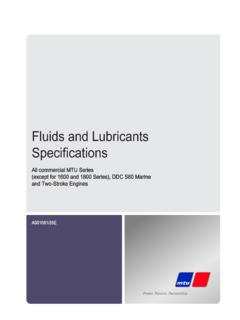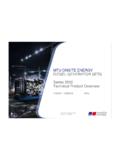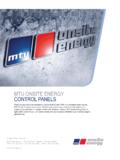Transcription of Understanding tier 4 interim and tier 4 Final ... - …
1 All current tier 2 and tier 3 diesel generator sets in their applicable horsepower categories will be in EPA compliance through 2015 and beyond when used strictly for emergency standby power (ESP). Understanding tier 4 interim and tier 4 Final eP a regUlations For generator set aPPlications While tier 4 standards that begin to take effect in 2011 do not apply to generator sets used strictly for emergency standby power (with possible exceptions for California and non-attainment areas), power system specifiers and owners need to be aware of how the regulations will affect other genset Environmental Protection Agency (EPA)
2 Began to enforce limits on diesel exhaust emissions from nonroad diesel engines in 1996 and stationary diesel-engine generator sets in 2006. Implemented in a series of steps called tier levels, these regulations, over time, have introduced successively more stringent limitations on nitrogen oxides (NOx), carbon monoxide (CO), particulate matter (PM) and non-methane hydrocarbons (NMHC). In response to these regulations, engine manufacturers began introducing innovative design changes and sophisticated engine control systems that have successfully reduced the major pollutants in diesel exhaust to comply with each successive tier level.
3 Currently, all major generator set manufacturers offer products that comply with tier 2, tier 3 or tier 4 interim standards in various horsepower categories. This paper will explain the latest and near-term emissions requirements for generator set applications and discuss the technologies used to comply with the new emissions redUctionsSince the introduction of regulations in the mid-1990s, nonroad diesel emissions have been dramatically reduced. (See Figure 1.) By the time tier 4 Final is introduced in 2014 and 2015, NOx and PM emissions from diesel exhaust will have been reduced by 99 is important to remember that the EPA emissions regulations vary by the horsepower rating of the generator engine (or the metric mechanical kW equivalent), not the kilowatt capacity listed on the generator nameplate.
4 The tier requirements have been written and implemented over an 18-year period that will culminate in 2015 with tier 4 Final . The next big emissions reduction for medium to large generator sets begins in 2011 with tier 4 interim standards and concludes in 2014 and 2015 with tier 4 Final standards. (See Figure 2.)Emergency standby power (ESP) exceptionThroughout most of the United States, diesel-engine and gas-engine generator sets used strictly for emergency standby power (ESP) are exempt from EPA tier 4 interim and tier 4 Final regulations.
5 ESP installations have been exempted because tier 2 and tier 3 engine generators already exhibit emissions reductions of over 85 percent that have come about through in-engine design improvements. Additionally, because ESP units typically run fewer than 200 hours per year, their emissions have been judged to have an insignificant impact on local air quality. In fact, there are no time limits on running ESP generators in true emergency situations due to utility outages or equipment malfunctions. This means that all current tier 2 and tier 3 diesel generator sets in their applicable horsepower 2010/ // / mtU onsite energy TOGNUM GROUP BRANDBy Christine Ueno Regulatory Compliance ManagerMTU Onsite EnergyMankato, Minnesotacategories will be in EPA compliance through 2015 and beyond when used strictly for ESP.
6 (See Figure 3.) ESP installations are also allowed up to 100 hours of running time per year for testing and , while ESP generator sets are exempt from tier 4 interim and tier 4 Final standards on a federal level, local authorities can enforce more stringent regulations. California, due to its persistent air quality problems and advanced regulatory initiatives, may require compliance with tier 4 interim standards in 2011 and tier 4 Final standards in 2014 2015 for all generator set installations, including ESP. Engine manufacturers have argued that it would be in the best interest of customers and the environment for California to adopt the federal exemption for ESP.
7 Manufacturers believe they will likely be successful in getting some regulatory relief for ESP in California before the new rules become parts of the country may also have more stringent regulations, especially in areas where municipalities have not attained current EPA air quality standards. These non-attainment areas are generally large population centers where due to either high local emissions or local weather conditions, ozone concentration exceeds EPA recommendations. Since NOx is a precursor to atmospheric ozone, non-attainment areas have sought to exercise greater control over point-sources of NOx.
8 In order for municipalities to comply with emissions regulations in non-attainment areas, all diesel-engine and gas-engine generator sets may be required to comply with tier 4 interim in 2014 and eventually tier 4 Final in 2015. (See Figure 4.)Non-ESP applicationsFor applications other than ESP, tier 4 regulations for generator sets will be phased in in two steps, beginning with tier 4 interim in 2011. tier 4 Final will be required for small nonemergency generator sets beginning in 2013 and eventually all nonemergency generator sets by 2015.
9 To achieve the level of emissions control required to meet tier 4 interim and tier 4 Final standards, some form of exhaust aftertreatment will be set applications that will be required to comply with tier 4 interim in 2011 and tier 4 Final in 2014 (<750 hp) and 2015 (>750 hp) include:// Load management or peak shaving applications including any generator sets paralleled with the local utility and used in curtailment programs. While these generator sets may also be used for ESP, their secondary use for load management disqualifies them for exemption from tier 4 interim and tier 4 Prime power applications where the generator set is used as the primary source of electrical power due to the unavailability of normal utility Applications involving mobile rental power units including temporary power used at construction sites, seasonal utility peaking, special events or any other temporary power application.
10 2010/ // / mtU onsite energy // / Understanding tier 4 ePa regUlationsA TOGNUM GROUP BRANDF igure 1. By the time tier 4 Final regulations are introduced in 2014 and 2015, NOx and PM emissions from off-highway diesel engines will have been reduced by 99 percent. ~ <G8 DF9@C< F== ?@>?N8P I<>LC8K@FEJ BN EFp <eakkagfk _ cN `j ~ ~~ ~ j]\m[lagfeP a moBile oFF-highway regUlations (225kw to 559kw)// Spark-ignited engine generators in non-ESP applications including generator sets running on natural gas, LP, or methane collected from landfills, sewage treatment or coal seams.


